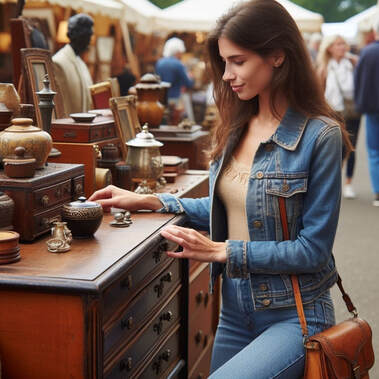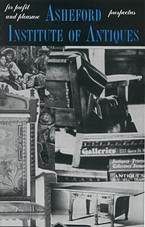|
Style Gurus & Design Experts Have Their Say...  "Brown Is Back"... According To Some "Brown Is Back"... According To Some New York - According to a number of reports coming from the front-lines of the decorative arts scene, it appears that the corner may have finally been rounded for the long awaited return of 'brown' furniture's status as an in-style icon. After years of all-white, minimalist interiors, brown furniture - the kind associated with most antique shops - is no longer suffering from the 'brown is down' moniker, and instead seems to be riding a wave of popularity putting it back into form and fashion with designers, dealers, and collectors alike. Magazines and international newspapers, such as Homes & Gardens, The Telegraph, and digital lifestyle media companies like PureWow, are all awash in stories of the power of 'browns' return to prominence within the decorative arts industry. Individually renowned designers such as Martin Waller, founder of the Andrew Martin design firm, and Suzanne Duin, from acclaimed Maison Maison interiors, also seem to be in agreement that it's 'browns' time to shine once more. Duin says she shares her colleagues belief that 'there's a desire for the natural and a craving for earthy themed tones again,' but also thinks that brown wood has a broader general appeal and is a 'warmer and more contemporary alternative to just a grey decorating canvas.' For Harold Blum, who's manages one of Philadelphia's largest antique and interior design firms, it's been like an ever-changing world of trends that seem to come and go like the seasons. From minimalist Scandinavian aesthetics to bold maximalist statements, Blum says homes have reflected the prevailing tastes of the moment, but now believes that amidst this ever-shifting landscape, there’s a quiet revolution happening that's celebrating the return of brown antique furniture as much more than just a passing trend. "Our sales of Georgian inspired Victorian pieces are selling into homes that were once white-washed with a modern motif," says Blum, "with some even being repeat customers who just a few short years ago were only interested in purchasing Mid-Century." Blum thinks that as many of these younger buyers age into their forties, and acquire 'forever' homes, the desire for warmer and more traditional furniture will start to take hold.  Interior Design Requests For Brown Wood Rise Interior Design Requests For Brown Wood Rise In design groups across the Internet, there have also been rumblings on a number of related forums and websites recently about the rise and return of brown furniture to it's famed decorative status. Kimberley Hill & Associates, a design consulting firm that also hosts online forums related to decorating, says that for years brown furniture was unfairly labeled as dated, heavy, and clunky. "It was the kind of furniture that often ended up in yard sales or was hidden away in attics," says Hill. However, a group of contemporary designers and colleagues who work with Hill, say they're ready to challenge this perception. They see the intrinsic value of these pieces - crafted from solid, dark woods like walnut, teak, rosewood, and mahogany - as essential contributors to a well-rounded and soulful living space. "Our requests from clients for dark wood has gone up tenfold in the past two years," says Hill, "but it's not just us experiencing the surge, other designers on decorative forums say they're seeing the same level of increased interest as well." David Knowles, who's been showing at some of the largest antique fairs up and down the east coast for over forty years, says he's relieved to see the pendulum finally beginning to swing back to the 'brown side of town' again. As a dealer, Knowles says he remembers the heyday of brown furniture back in the 1980's, and admits that while it's nothing like that yet, he still feels that the tide has finally turned. "It may just be an east coast thing for the moment," concedes Knowles, "but it's definitely taken root, and from what I've seen, it only looks to be gaining traction." Knowles says that many of the younger dealers who also attend some of the same shows as he, have also begun to add more dark furniture to their repertoire of inventory. "The numbers are up," says Knowles, "which means that if you happen to be sitting on a well-stocked supply of items, or bought cheaply enough in the past, you're probably going to see some pretty decent profits in the next little while." Of course, no one is suggesting you have to go all-in when it comes to buying and decorating with brown furniture, but as online vintage designer and retailer Madeline Smith likes to remind her clients, "It's all about balance." Smith who's been buying and selling for almost twenty-five years says that the key to incorporating brown furniture into any design motif comes down to three simple concepts. "First, work sparingly. Rather than filling an entire room with dark pieces, choose one or two standout items. Make them focal points that add depth and character. Whether it’s a chocolate brown antique leather sofa or a beautifully grained wooden sideboard, less can indeed be more. Second, mix and match. Don’t limit yourself to a single wood finish. Mixing different wood species and finishes adds uniqueness to your space. Pair golden teak with rich dark walnut against taupe or grey walls for definition and contrast. And finally, try to seek balance. To avoid the dark and dreary look, accentuate brown furniture with lighter accents." Smith says that by not opting for just the 'brown' look with her clients, and instead advocating for a more evenly distributed approach, she's actually sold more dark furniture recently than ever before. "Sometimes less can be much more," says Smith, "don't try to oversell it, especially if it's starting to sell itself." While most design experts and industry-insiders would probably agree that brown furniture has certainly not returned to the forefront of the decorative arts movement just yet, there is also likely to be a simultaneous consensus from many in the business that a trend-revival and resurgence of the 'brown' motif is already well on its way. Once considered passé, it would now appear that many of these pieces are suddenly making a triumphant return, reclaiming their place in contemporary interiors while captivating designers and homeowners alike with their timeless charm and enduring appeal. - A.I.A. Staff Writers  NOTE: For readers seeking more information about the Asheford Institute Of Antiques distance-learning program on professional-level appraising, the study of antiques, collectibles, vintage and mid-century modern items, please click here to visit the school's Home Page. Should you have additional questions about the Asheford program, you can also write to the school at: [email protected] or call the Registrar's Office toll-free at: 1-877-444-4508. Comments are closed.
|
AIA StaffWe're providing our students and reader's with the latest breaking news on events and happenings that we think might be of interest to both collectors and dealers alike. Including changes within the world of antiques, vintage, collectibles and appraising that might just have an effect on your bottom line. We're also interested in hearing from you - so if you've got a great newsworthy story, let us know, and you just might find it here! Archives
July 2024
CategoriesLegal Disclaimer: Extraneous opinions, statements and comments made by individuals represented within these posts do not necessarily reflect those of the Institute. The publication naming of specific business entities, organizations, and concerns, contained herein, in no way represents an endorsement or recommendation of services or products by the Institute. Publicly identifiable information contained herein (including, but not limited to contact information), has been intentionally limited where possible, due to privacy and legal concerns related to the digital dissemination of information through online means. All views expressed herein are those of their respective owners. The Institute is in no way responsible, financially or otherwise, for the accuracy or validity of statements contained within published posts from sources that originate and appear outside of the written and expressed views of those submitted by the Institute.
|



 RSS Feed
RSS Feed




